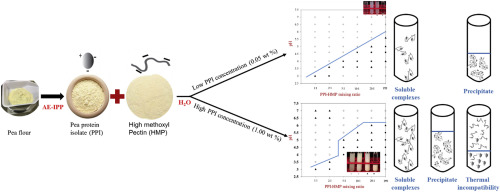当前位置:
X-MOL 学术
›
Food Hydrocoll.
›
论文详情
Our official English website, www.x-mol.net, welcomes your feedback! (Note: you will need to create a separate account there.)
Pea protein isolate–high methoxyl pectin soluble complexes for improving pea protein functionality: Effect of pH, biopolymer ratio and concentrations
Food Hydrocolloids ( IF 10.7 ) Pub Date : 2018-07-01 , DOI: 10.1016/j.foodhyd.2018.02.021 Yang Lan , Bingcan Chen , Jiajia Rao
Food Hydrocolloids ( IF 10.7 ) Pub Date : 2018-07-01 , DOI: 10.1016/j.foodhyd.2018.02.021 Yang Lan , Bingcan Chen , Jiajia Rao

|
Abstract Recently, there is a strong interest in the incorporation of pea protein as a preferred alternative animal protein into protein fortified beverage because of its cheaper price, more sustainable and gluten free that can be claimed in label. However, poor functionality of pea protein such as acidic solubility and thermal stability has limited their applications in dispersed food systems such as beverage. The aim of this study was to enhance the functionality of pea protein isolate (PPI) by forming soluble complexes with high methoxyl pectin (HMP). The effect of PPI–HMP mixing ratio (1:1–20:1) and PPI concentrations (0.05 and 1.00 wt %) on critical pH transition point (pHs), a key parameter differentiating between soluble and insoluble complexes formation, was investigated using turbidimetric analysis, phase diagram, and ζ–potential. Critical pHs decreased to pH 3.5 as PPI–HMP mixing ratio decreased from 20:1 to 1:1. The ζ–potential results showed a shift in net charge neutrality from pH 4.8 in homogenous PPI solutions to pH 3 for PPI-HPM mixtures with 1:1 ratio. However, HMP induced phase separation of PPI–HMP mixtures at both higher biopolymer concentration (>1.50 wt %) and neutral pH values was observed presumably via a thermal incompatibility mechanism. The pH- percentage solubility of PPI–HMP mixtures at fixed PPI concentration (1.00 wt %) was mixing ratio dependent. When increasing HMP concentration, the pH of minimum protein solubility for biopolymer mixture was shifted towards more acidic condition as compared to PPI alone. Apparent viscosity and thermal denaturation temperature of soluble complexes at fixed PPI concentration (1.00 wt %) slightly increased due to the formation of new net structure in the PPI–HMP systems. The findings derived from this research could provide useful information in the design of pea protein fortified beverage with enhanced pea protein stability.
中文翻译:

豌豆分离蛋白-用于改善豌豆蛋白质功能的高甲氧基果胶可溶性复合物:pH、生物聚合物比例和浓度的影响
摘要 最近,由于豌豆蛋白价格更便宜、更可持续且不含麸质且可在标签上声明,因此人们对将豌豆蛋白作为首选的替代动物蛋白加入蛋白质强化饮料引起了浓厚的兴趣。然而,豌豆蛋白的酸性溶解度和热稳定性等较差的功能限制了它们在饮料等分散食品系统中的应用。本研究的目的是通过与高甲氧基果胶 (HMP) 形成可溶性复合物来增强豌豆分离蛋白 (PPI) 的功能。使用 PPI-HMP 混合比(1:1-20:1)和 PPI 浓度(0.05 和 1.00 wt%)对临界 pH 转变点(pHs)的影响,这是区分可溶性和不溶性复合物形成的关键参数。浊度分析、相图和 ζ 电位。随着 PPI-HMP 混合比从 20:1 降低到 1:1,临界 pH 值降低到 pH 3.5。ζ 电位结果表明,净电荷中性从均质 PPI 溶液的 pH 4.8 转变为 1:1 比例的 PPI-HPM 混合物的 pH 3。然而,在较高生物聚合物浓度(> 1.50 wt%)和中性 pH 值下,HMP 诱导 PPI-HMP 混合物发生相分离,这可能是通过热不相容性机制观察到的。PPI-HMP 混合物在固定 PPI 浓度(1.00 重量%)下的 pH 百分比溶解度取决于混合比。当增加 HMP 浓度时,与单独的 PPI 相比,生物聚合物混合物的最小蛋白质溶解度的 pH 值向更酸性的条件移动。固定 PPI 浓度下可溶性复合物的表观粘度和热变性温度 (1. 由于在 PPI-HMP 系统中形成新的网状结构,00 wt %) 略有增加。这项研究的发现可以为设计具有增强豌豆蛋白质稳定性的豌豆蛋白质强化饮料提供有用的信息。
更新日期:2018-07-01
中文翻译:

豌豆分离蛋白-用于改善豌豆蛋白质功能的高甲氧基果胶可溶性复合物:pH、生物聚合物比例和浓度的影响
摘要 最近,由于豌豆蛋白价格更便宜、更可持续且不含麸质且可在标签上声明,因此人们对将豌豆蛋白作为首选的替代动物蛋白加入蛋白质强化饮料引起了浓厚的兴趣。然而,豌豆蛋白的酸性溶解度和热稳定性等较差的功能限制了它们在饮料等分散食品系统中的应用。本研究的目的是通过与高甲氧基果胶 (HMP) 形成可溶性复合物来增强豌豆分离蛋白 (PPI) 的功能。使用 PPI-HMP 混合比(1:1-20:1)和 PPI 浓度(0.05 和 1.00 wt%)对临界 pH 转变点(pHs)的影响,这是区分可溶性和不溶性复合物形成的关键参数。浊度分析、相图和 ζ 电位。随着 PPI-HMP 混合比从 20:1 降低到 1:1,临界 pH 值降低到 pH 3.5。ζ 电位结果表明,净电荷中性从均质 PPI 溶液的 pH 4.8 转变为 1:1 比例的 PPI-HPM 混合物的 pH 3。然而,在较高生物聚合物浓度(> 1.50 wt%)和中性 pH 值下,HMP 诱导 PPI-HMP 混合物发生相分离,这可能是通过热不相容性机制观察到的。PPI-HMP 混合物在固定 PPI 浓度(1.00 重量%)下的 pH 百分比溶解度取决于混合比。当增加 HMP 浓度时,与单独的 PPI 相比,生物聚合物混合物的最小蛋白质溶解度的 pH 值向更酸性的条件移动。固定 PPI 浓度下可溶性复合物的表观粘度和热变性温度 (1. 由于在 PPI-HMP 系统中形成新的网状结构,00 wt %) 略有增加。这项研究的发现可以为设计具有增强豌豆蛋白质稳定性的豌豆蛋白质强化饮料提供有用的信息。



























 京公网安备 11010802027423号
京公网安备 11010802027423号